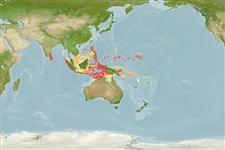>
Eupercaria/misc (Various families in series Eupercaria) >
Malacanthidae (Tilefishes)
Etymology: Hoplolatilus: Greek, hoplon = weapon + Latin, latus = wide (Ref. 45335); randalli: Named for John E. Randall, in recognition of his numerous valuable contributions to our knowledge of Indo-Pacific fishes and particularly his previous work on the genus Hoplolatilus..
Environment: milieu / climate zone / depth range / distribution range
Ecologia
marinhas associadas(os) a recifes; intervalo de profundidade 30 - 85 m (Ref. 85568). Tropical
Indo West Pacific: Indonesia, Philipines, Palau, Yap Is. and the Solomon Islands.
Tamanho / Peso / Idade
Maturity: Lm ? range ? - ? cm
Max length : 15.4 cm SL macho/indeterminado; (Ref. 85568)
Descrição breve
Morfologia | Morfometria
Espinhos dorsais (total): 10; Raios dorsais moles (total): 13; Espinhos anais 2; Raios anais moles: 12; Vértebras: 24. This species is distinguished by the following characters: D X,13; A II,12; pectoral rays 17; total gill rakers on first branchial arch 27-29; pored lateral line scales 84-92 with 98-120 scales in lateral series above lateral line; preopercular serrae 16-23; greatest body depth 3.4-3.9 in SL; length of last dorsal spine 2.5-3.0 in HL; longest soft dorsal ray 1.1-1.4 in HL; colour in life mainly greenish (darker dorsally), shading to light blue on lower head, thorax, and abdomen; caudal peduncle with an elongate sky aqua-blue saddle-like spot dorsally; narrow sky-blue band from front of snout to lower edge of eye; lips mainly blue; narrow yellow-orange band just below blue band, passing just under eye to posterior margin of preoperculum; dorsal and anal fins pale yellow with pink margin; caudal fin reddish with indistinct central pale streak, the upper and lower margins narrowly light blue to pinkish; pectoral fins mainly translucent except upper 4-5 rays blue; pelvic fins bluish white; iris yellow with bright blue streak dorsally and ventrally (Ref. 85568).
Inhabits gentle rubble slopes; constructs impressive rubble mounds over its burrows, which range from about 50-70 cm in height and 1.5-2 m in diameter and typically, the fish are seen hovering a short distance from their home mound, with up to six individuals using a single mound. The fish when approached closely or frightened by spear shots, quickly retreat
into the burrow, which is located near the apex of the mound (Ref. 85568).
Life cycle and mating behavior
Maturidade | Reprodução | Desova | Ovos | Fecundidade | Larvas
Allen, G.R., M.V. Erdmann and A.M. Hamilton, 2010. Hoplolatilus randalli, a new species of sand tilefish (Pisces: Malacanthidae) from the tropical western Pacific with comments on the validity of H. luteus. aqua, Int. J. Ichthyol. 16(4):171-186. (Ref. 85568)
Categoria na Lista Vermelha da IUCN (Ref. 130435)
Ameaça para o homem
Harmless
Utilização humana
Mais informação
Nomes comunsSinónimosMetabolismoPredadoresEcotoxicologiaReproduçãoMaturidadeDesovaAgregação para desovaFecundidadeOvosDesenvolvimento dos ovos
Idade/TamanhoCrescimentoComprimento-pesoComprimento-comprimentoFrequência de comprimentoMorfometriaMorfologiaLarvasDinâmica larvarRecrutamentoAbundânciaBRUVS
ReferênciasAquaculturaPerfil para aquaculturaEstirpesGenéticaElectrophoresesHereditariedadeDoençasProcessamentoNutrientsMass conversion
ColaboradoresFotografiasStamps, Coins Misc.SonsCiguateraVelocidadeTipo de nataçãoÁrea branquialOutras referênciasCérebrosVisão
Ferramentas
Relatórios especiais
Descarregue XML
Fontes da internet
Estimates based on models
Preferred temperature (Ref.
123201): 26.7 - 28.6, mean 27.6 °C (based on 41 cells).
Phylogenetic diversity index (Ref.
82804): PD
50 = 0.5001 [Uniqueness, from 0.5 = low to 2.0 = high].
Bayesian length-weight: a=0.01122 (0.00514 - 0.02450), b=3.04 (2.87 - 3.21), in cm total length, based on all LWR estimates for this body shape (Ref.
93245).
Nível Trófico (Ref.
69278): 3.5 ±0.5 se; based on size and trophs of closest relatives
Fishing Vulnerability (Ref.
59153): Low vulnerability (10 of 100).
